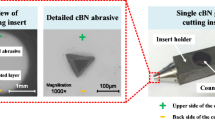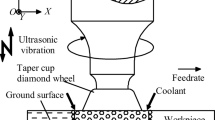Abstract
The paper presents an experimental study of micro-cutting intended to aid the optimization of the grinding process of the oxide–carbide ceramic BOK 60. The necessity for investigating the mechanisms occurring between the abrasive material and the ceramic is imposed by the fact that grinding is the dominant technology used to achieve the required quality of the workpiece surface finish. The investigations were carried out to determine the normal and tangential cutting forces, the critical penetration depth, and the crack generation angle on the workpiece surface as a function of the grain penetration speed and depth. The micro-cutting process was performed with a single diamond cone-shaped grain at varying depths of cut. It was found that the critical grain penetration depth separating ductile flow from brittle fracturing ranges from 3 to 5 μm, while radial cracks on the ceramic’s surface are distributed at an angle from 35° to 75°, measured relative to the direction of the diamond grain’s motion.
Similar content being viewed by others
References
Pai DM, Ratterman E, Shaw MC (1989) Grinding swarf. Wear 131(2):329–339
Agarwal S, Rao PV (2008) Experimental investigation of surface/subsurface damage formation and material removal mechanisms in SiC grinding. Int J Mach Tools Manuf 48(6):698–710. doi:10.1016/j.ijmachtools.2007.10.013
Latella BA, Liu T, Atanacio AJ (2002) Effect of grain size on Hertzian contact damage in 9 mol % Ce-TZP ceramics. J Eur Ceram Soc 22(12):1971–1979
Zhang J, Sakai M (2004) Geometrical effect of pyramidal indenters on the elastoplastic contact behaviors of ceramics and metals. Mater Sci Eng 381(1–2):62–70
Yonezu A, Xu B, Chen X (2009) Indentation induced lateral crack in ceramics with surface hardening. Mater Sci Eng 507(1–2):226–235
Lawn BR, Wilshaw R (1975) Indentation fracture: principles and applications. J Mater Sci 10:1049–1081
Wang Y, Darvell BW (2007) Failure mode of dental restorative materials under Hertzian indentation. Dent Mater 23(10):1236–1244
Chai H, Lawn BR (2007) A universal relation for edge chipping from sharp contacts in brittle materials: a simple means of toughness evaluation. Acta Materialia 55(7):2555–2561
Anton RJ, Subhash G (2000) Dinamic vickers indentation of brittle materials. Wear 239(1):27–35
Mishnaevsky LL (1994) Investigation of the cutting of brittle materials. Int J Mach Tools Manuf 34:499–505
Nakajima T, Uno Y, Fujiwara T (1989) Cutting mechanisms of fine ceramics with a single point diamond. Precis Eng 11(1):19–25
Desa O, Bahadur S (2001) The effect of lubricants in single point scratching and abrasive machining of alumina and silicon nitride. Wear 251(1–12):1085–1093. doi:10.1016/S0043-1648(01)00728-1
Tanovic LJ, Bojanic P, Puzovic R, Klimenko S (2009) Experimental investigation of microcutting mechanisms in marble grinding. J Manuf Sci Eng 131(6):064507. doi:10.1115/1.4000619, 5 pages
Chen C, Jung Y, Inasaki I (1989) Surface, cylindrical and internal grinding of advanced ceramics, grinding fundamentals and applications. Malkin S, Kovach JA (eds) PED vol. 39, ASME: 201–211
Xu HHK, Padture NP, Jahanmir S (1995) Effect of microstructure on material-removal mechanism and damage tolerance in abrasive machining of silicon carbide. J Am Ceram Soc 79:2443–2448
Xu HHK, Wei L, Jahanmir S (1995) Grinding force and microcrack density in abrasive machining of silicon nitride. J Mater Res 10(12):3204–3209
Zhang B (1999) Helical scan grinding of brittle and ductile materials. J Mater Process Technol 91(1–3):196–205
Chen X, Rowe WB (2002) Analysis and simulations of the grinding process. Part 1: generation of the grinding wheel surface. Int J Mach Tools Manuf 36(8):871–882
Huang H, Liu YC (2003) Experimental investigations of machining characteristics and removal mechanisms of advanced ceramics in high speed deep grinding. Int J Mach Tools Manuf 43(8):811–823
Huang H, Liu ZC (2003) Experimental investigations of machining characteristics and removal mechanisms of advanced ceramics in high speed deep grinding. Int Jour of Mach Tools and Manuf 43(8):811–823
Zhong ZW (2003) Ductile or partial ductile mode machining of brittle materials. Int J Advanced Manuf Technol 21(8):579–585
Marshall DB, Lawn BR, Cook RF (1987) Microstructural effects on grinding of alumina and glass-ceramics. J Am Ceram Soc 70(6):139–140
Zhang B, Zheng XL, Tokura H, Yoshikawa M (2003) Grinding induced damage in ceramics. J Mater Process Technol 132(1–3):353–364
Xie Z-H, Moon RJ, Hoffman M, Munroe P, Cheng Y-B (2003) Role of microstructure in the grinding and polishing of α-sialon ceramics. J Eur Ceram Soc 23(13):2351–2360
Conway JC Jr, Kirchner HP (1980) The mechanics of crack initiation and propagation beneath a moving sharp indenter. J Mater Sci 15:2879–2883
Conway JC Jr, Kirchner HP (1986) Crack branching as a mechanism of crushing during grinding. J Am Ceram Soc 69:603–607
Malkin S, Hwang TW (1996) Grinding mechanisms for ceramics. Annals CIRP 45(2):569–580
Author information
Authors and Affiliations
Corresponding author
Rights and permissions
About this article
Cite this article
Tanovic, L., Bojanic, P., Popovic, M. et al. Mechanisms in oxide-carbide ceramic BOK 60 grinding. Int J Adv Manuf Technol 58, 985–989 (2012). https://doi.org/10.1007/s00170-011-3449-5
Received:
Accepted:
Published:
Issue Date:
DOI: https://doi.org/10.1007/s00170-011-3449-5




